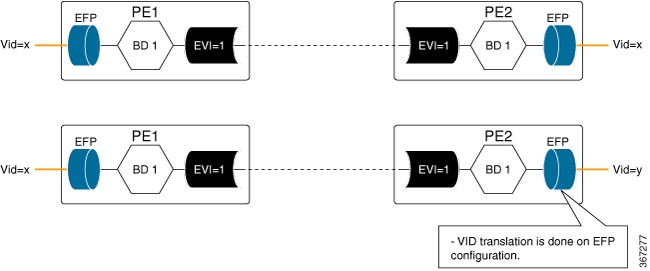When the EVPN prefix is imported into the VPN VRF table, a new VPN prefix may be reoriginated. Updates may be sent to another
VPN neighbor based on the configuration. The reoriginated prefix is the imported VPN prefix where the route target extended
communities are replaced with a new set of route target extended communities.
To configure route reorigination, use the following configuration:
enable
configure terminal
router bgp 100
address-family vpnv4|vpnv6
import l2vpn evpn [re-originate [stitching-rt]]
When the
import {vpnv4 | vpnv6}
unicast
command is configured under the L2VPN EVPN address-family configuration mode and if the route targets of the VPNv4 or VPNv6
route are within the export stitching route targets, the reoriginated EVPN prefix retains the same route targets. Otherwise,
route targets of reoriginated EVPN prefix are swapped using export stitching route target configuration.
When the
import {vpnv4 | vpnv6}
unicast
re-originate command is configured under the L2VPN EVPN address-family, the reoriginated EVPN prefix route target is replaced by the export
stitching route targets.
When the
import {vpnv4 | vpnv6}
unicast
command is not configured, then remote VPNv4 or VPNv6 prefix is not imported into EVPN table.
When the import l2vpn evpn command is configured under the VPNv4 or VPNv6 address family and if the route targets of the EVPN prefix are within the
subset of normal VRF export route targets in VRF, the imported VPNv4 or VPNv6 prefix retains the same route targets. Otherwise,
the imported VPNv4 or VPNv6 route targets are swapped with the VRF export route targets and advertised to VPNv4/VPNv6 neighbors.
When the import l2vpn evpn re-originate command is configured under the VPNv4 or VPNv6 address-family, the route targets of the imported VPNv4 or VPNv6 prefix are
replaced with the VRF export route targets and advertised to VPNv4/VPNv6 neighbors.
When the import l2vpn evpn re-originate stitching-rt command is configured, the imported VPN prefix route target is replaced by the VRF import stitching route target and advertised
to VPNv4 or VPNv6 neighbors.

Note
|
When the import l2vpn evpn command is not configured, the imported VPN prefix is not advertised to VPN neighbors.
|





 Feedback
Feedback